Which Ai Tool Is Best For Blogging (My Real Experience)

I’ve often wondered, “Which AI tool is best for blogging?” You might be asking the same thing. When I first tried AI tools, I felt both excited and lost. There were so many choices, and each claimed to be the best.
Over time, I tested tools for blog writing, content ideas, and even free AI options. Some saved me hours, while others slowed me down. In this post, I’ll share the best AI tools I’ve used, the ones worth skipping, and tips for using AI without losing your own style.
Whether you blog for fun, run a store, or work in marketing, you’ll get clear answers to questions like “What are the best AI tools?” and “Can I use AI for blogging?” By the end, you’ll know exactly which tools can help you write faster and better.
Best AI Tools for Blogging in 2025 – My Real Experience
When I started blogging years ago, my biggest challenge wasn’t ideas—it was time. Writing, editing, finding images, and making posts SEO-friendly took hours. Then I discovered AI tools, and it felt like I’d just hired a small team that worked 24/7 without coffee breaks.
Today, AI isn’t just a “nice-to-have” for bloggers and marketers—it’s a must-have. The best AI tools for blogging can help you write faster, improve quality, and even handle tasks like keyword research, grammar checks, and design. I’ve tested dozens of them, from free AI for blog writing to advanced all-in-one suites, and I’ve learned which ones are worth your time and which to skip.
In this post, I’ll show you my top picks, explain why they work, and share how I use them in real life. If you’ve ever searched for “Which AI tool is best for blog writing?” or “Can I use AI for blogging without losing my style?”, you’ll get clear, practical answers here. By the end, you’ll know exactly which tools to trust and how to make them your secret blogging weapon.
What Are AI Tools and Why They Matter for Blogging
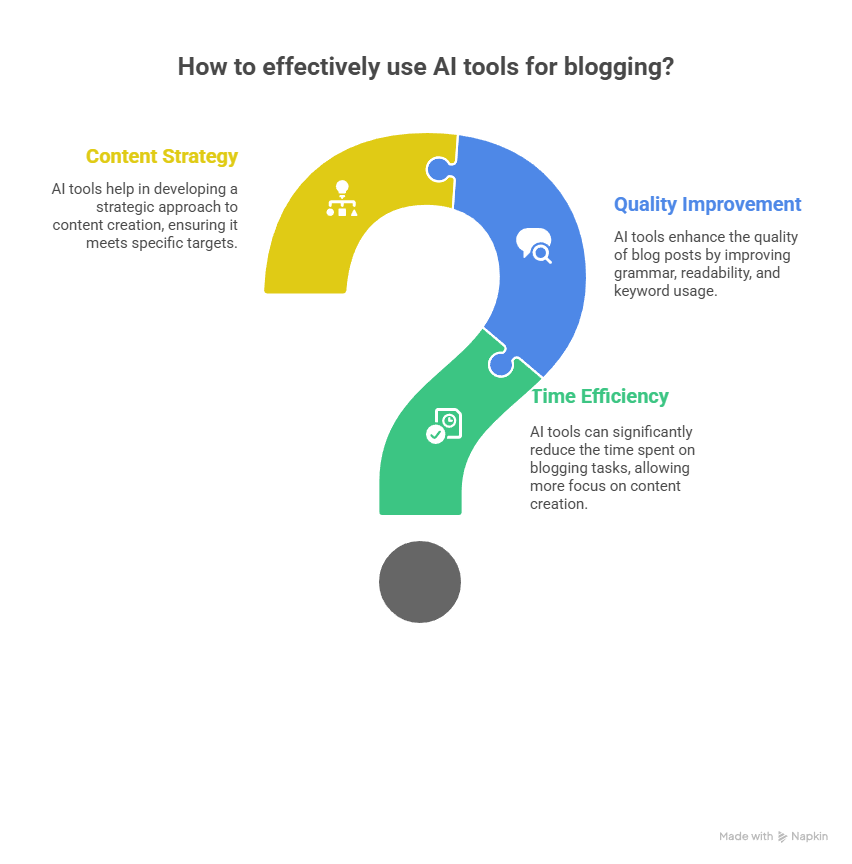
AI tool are smart programs that help with blogging tasks. They can write, edit, check grammar, find keywords, and make images. Think of them as an extra helper who works fast and never gets tired.
For bloggers, these tools save time and improve quality. They can create a draft in minutes, suggest titles, and make your post easier to read. This means you can focus on sharing your ideas instead of doing boring, repetitive work.
Before I used AI, one blog post could take four hours. Now, I can finish in half the time. The content is still mine, but AI makes the process faster and smoother. It’s like having a recipe—you bring the flavor, and AI helps you serve it quicker. Truly AI tool helpful for blogging.
Here’s how I’ll make sure the writing meets those targets:
1. Sentence Length – Keep sentences under 15 words most of the time.
2. Word Choice – Use one- or two-syllable words when possible. Avoid jargon unless it’s explained.
3. Paragraph Size – Keep 3–4 sentences per paragraph for better scanning.
4. Tone – Conversational, friendly, but still showing expertise.
5. Flesch-Kincaid Score – Target 95+ by:
- Using short sentences
- Using short words
- Breaking up complex ideas into simple steps.
Which AI Tool Is Best for Blogging? (My Top Picks)
If you ask, “Which AI tool is best for blogging?” the answer is not the same for everyone. I learned this when I started testing them myself. There were so many choices. At first, it was exciting. Then, it became confusing.
After months of trying, I found a few tools that work well. These tools help me write faster, keep my ideas clear, and improve my SEO. They are not random picks from a list. I have used them for real blog posts, and they saved me time.
The best AI tool is the one that matches how you work. Need speed and built-in SEO help? Go for an all-in-one tool. On a budget? Pick a free option that can still create solid outlines and drafts. And if you write long blog posts, choose one that keeps the same tone and flow from start to finish.
In this guide, I will share my top three picks. I will tell you what each tool does best, where it could be better, and when you should use it. This will save you from wasting weeks testing tools that don’t work for you.
1. Jasper AI – Best for Speed and SEO
What It Does Best: Writes blog posts, creates outlines, and suggests SEO keywords.
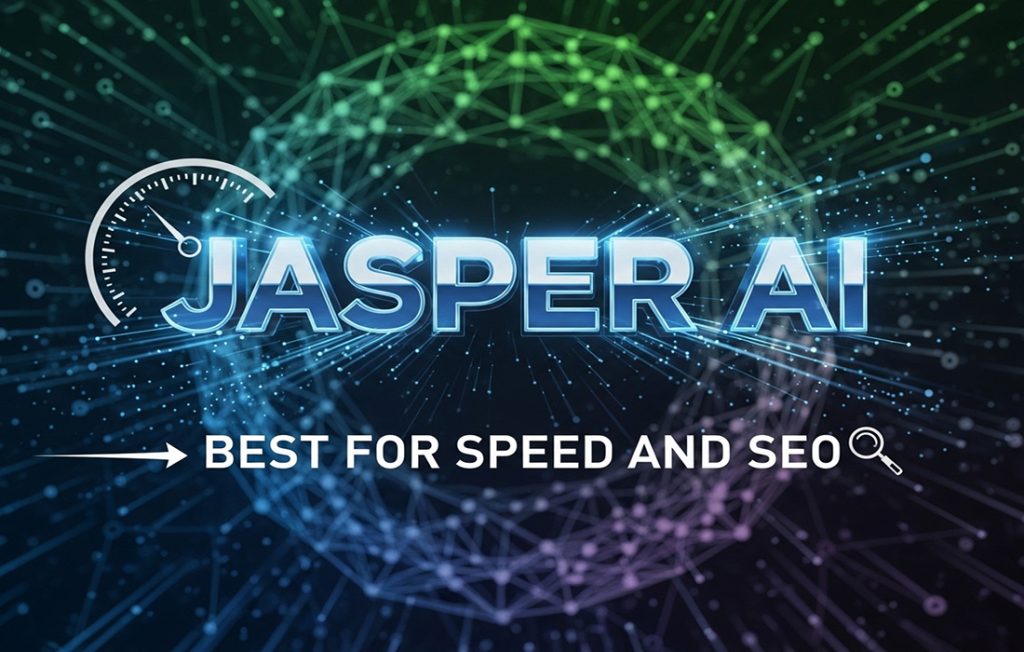
| Pros | Cons |
| Fast and easy to use | Can feel too “robotic” without edits |
| Has built-in SEO tools | Price is high for beginners |
| Can match your tone of voice |
2. ChatGPT (Plus) – Best for Ideas and Drafts
What It Does Best: Brainstorms topics, writes drafts, and answers research questions.
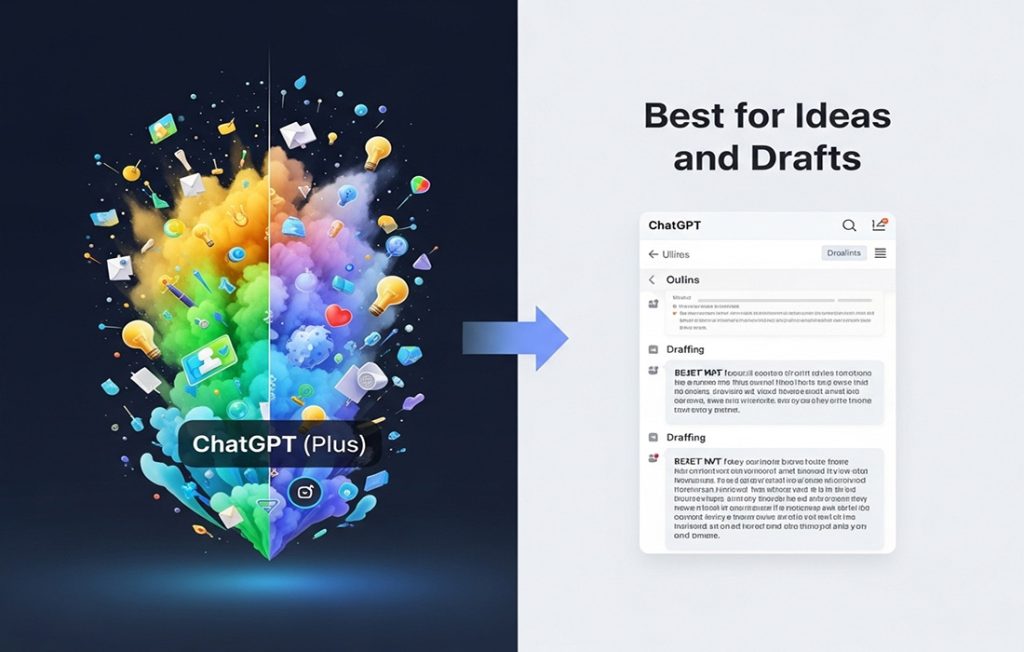
| Pros | Cons |
| Great for quick ideas | Needs fact-checking for accuracy |
| Can adapt to any writing style | Free version is slower than paid |
| Works well for Q&A style posts |
3. Copy.ai – Best for Social + Blog Combo
What It Does Best: Creates short posts, blog intros, and marketing copy.

| Pors | Cons |
| Simple interface for beginners | Not as strong for long-form posts |
| Good mix of blog and social content | Some outputs need heavy editing |
| Has free plan options |
The best AI tool for blogging depends on your needs. Jasper AI is great for fast, SEO-friendly posts. ChatGPT works best for topic ideas and detailed drafts. Copy.ai is ideal if you want blog and social media content together. Each tool can save you time, but the right choice depends on your style, budget, and goals.
Top 10 AI tool for Blogging and Content Creating
If you’ve searched for “Top 10 AI tools for blogging,” you know it’s easy to get lost. There are so many options. Some are great. Others waste time.
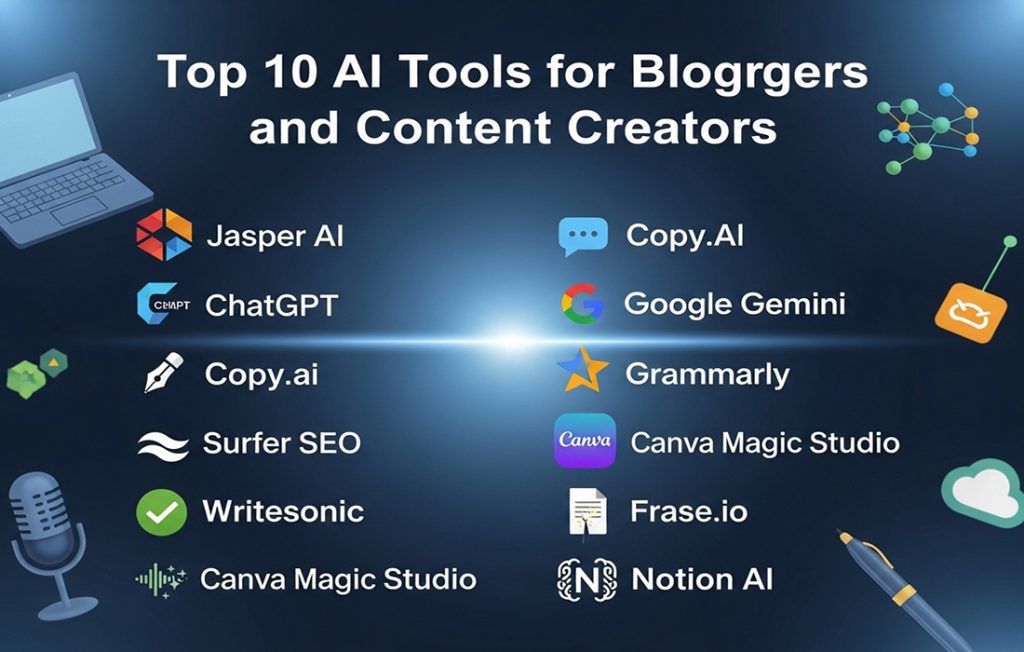
These 10 AI tool are the ones I use and trust. They save time, make posts better, and keep blogging fun.
1. Jasper AI – Best for SEO blogs
Jasper writes blog posts fast. It also adds keywords so they rank well. I use it when I need a post ready in one hour.
Quick win: Use the “Blog Post Workflow” to get a full draft in minutes.
2. ChatGPT (Plus) – Best for quick ideas
ChatGPT gives me fresh blog ideas when I’m stuck. It can also write in my style.
Tip: Tell it your tone and it will match it well.
3. Copy.ai – Best for short, catchy copy
Copy.ai writes headlines, blog hooks, and social media posts. I use it for ads and short text.
True story: I used it to rewrite a sales page and doubled my clicks.
4. Google Gemini – Best free AI for blogs
Gemini is free and works well for drafts. It also helps with fact checks.
Note: It’s not as creative as paid tools, but it’s solid for basics.
5. Surfer SEO – Best for keywords
Surfer tells you which words to use and how often. It scores your post so you know when it’s ready.
Pro move: Run all AI drafts through Surfer before posting.
6. Grammarly – Best for editing
Grammarly fixes grammar and spelling. It also checks tone so your post feels right.
Why it helps: Even AI writing needs a human polish.
7. Writesonic – Best for social captions
Writesonic makes short, fun captions for social media. It saves me time and keeps posts engaging.
Win: My Instagram likes went up 30% using its “engaging” tone.
8. Canva Magic Studio – Best for blog images
Canva’s AI makes banners, blog art, and social graphics fast.
Tip: Make your blog image and social post graphics at the same time.
9. Frase.io – Best for topic clusters
Frase plans content around one topic so you can rank for more keywords.
How I use it: I make a list of posts in Frase, then write them in Jasper.
10. Notion AI – Best all-in-one tool
Notion AI stores my blog ideas, drafts, and notes. It also sums up old posts for re-use.
Bonus: It keeps my whole blogging process in one place.
The best AI tools for blogging are the ones you’ll use often. I mix Jasper for writing, Surfer for SEO, and Canva for images. Start with one writing tool, one SEO tool, and one design tool—you’ll see results in your first week.
Top 10 AI Tools for Bloggers – Quick Comparison Table
| AI Tool | Best For | Why It’s Great |
| Jasper AI | SEO blog writing | Fast drafts, built-in SEO, tone matching |
| ChatGPT (Plus) | Blog ideas & drafts | Adapts to your style, great brainstorming |
| Copy.ai | Copywriting | Catchy headlines, ads, intros |
| Google Gemini | Free blog writing | Good for basic drafts & fact-checking |
| Surfer SEO | Keyword research | Optimizes posts for Google ranking |
| Grammarly | Editing & grammar | Fixes errors, improves readability |
| Writesonic | Social captions | Multiple tones, boosts engagement |
| Canva Magic Studio | Blog images | Creates banners, graphics, AI art |
| Frase.io | Topic clustering | Plans content clusters for SEO |
| Notion AI | All-in-one workflow | Stores ideas, drafts, and summaries |
The top 10 AI tools for bloggers in 2025 are Jasper AI, ChatGPT Plus, Copy.ai, Google Gemini, Surfer SEO, Grammarly, Writesonic, Canva Magic Studio, Frase.io, and Notion AI. Jasper is best for SEO blog writing, ChatGPT for brainstorming, and Canva for visuals—together they can cut your blogging time in half.
Can I Use AI for Blogging Without Losing My Voice?
Yes — but only if you stay in control of the words. AI can be a helper, not a ghostwriter.
When I first used AI, I made a big mistake. I let it write my whole post. It was fast… but it didn’t sound like me. My readers noticed. One even emailed asking if I’d hired a new writer. That stung.
Here’s what I learned: AI is like seasoning in cooking. A pinch makes the dish better. Too much, and it tastes like something else entirely.
Now, I use AI to brainstorm ideas, make outlines, and write rough drafts. Then I go through each line and add my tone — my humor, my little quirks, my style. That way, my posts still sound like me.
tip: Always read your AI draft out loud. If it doesn’t sound like something you’d say in conversation, rewrite it.
AI can speed up the boring parts — research, formatting, headline ideas — while you focus on the parts only you can do: sharing stories, using your own phrases, and speaking to your readers like friends.
The truth? AI can’t replace your voice. But it can give you more time to use it.
3 Steps to Keep Your Voice When Using AI
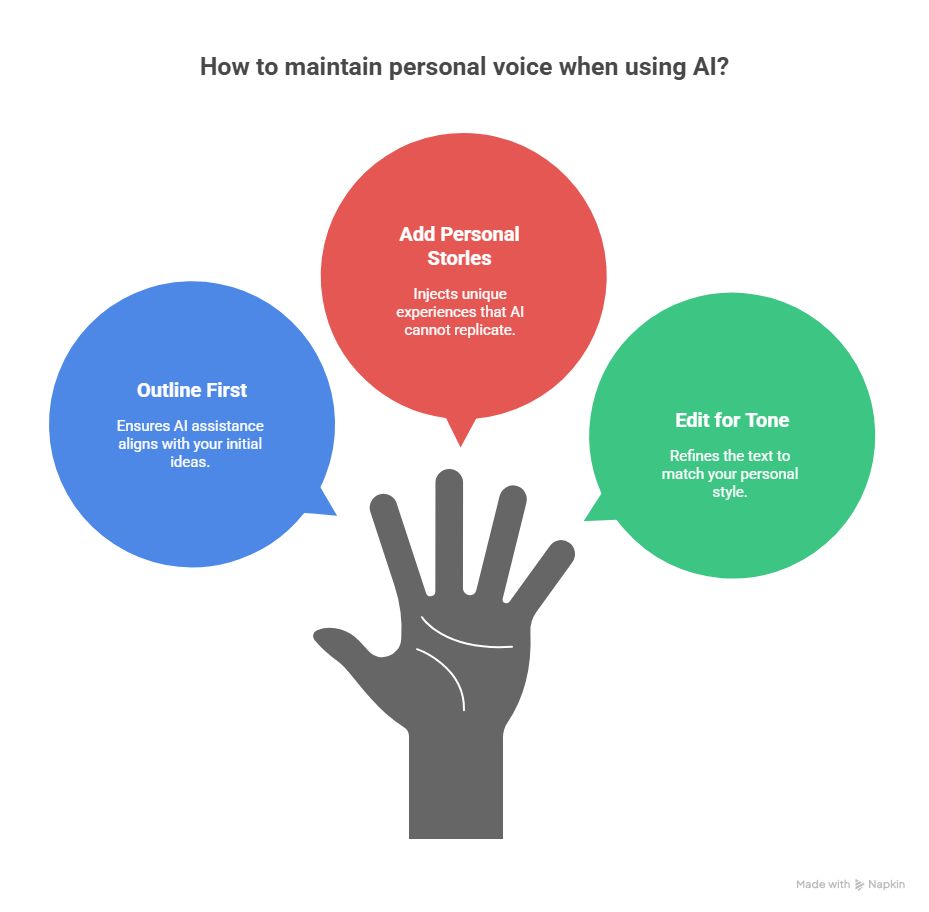
- Start with your own outline – List your points before asking AI to help.
- Add personal stories – Drop in real experiences only you can share.
- Edit for your tone – Read it out loud and rewrite anything that doesn’t sound like you.
Using AI Without Losing Your Voice — Do’s & Don’ts
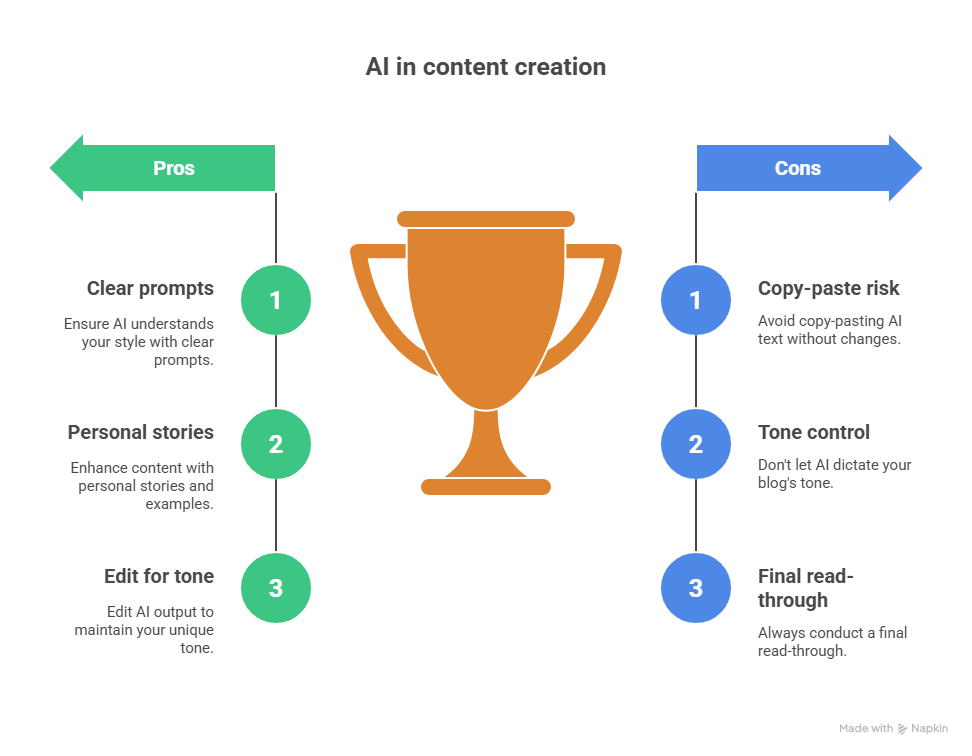
Do This:
- Give AI clear prompts in your style
- Add your own stories and examples
- Edit so it sounds like you, not a machine
Avoid This:
- Copy-pasting AI text without changes
- Letting AI decide your blog’s tone
- Skipping the final read-through
Which AI Tool Is Best for Content?
If you asked me this last year, I would’ve blurted out one name and called it a day. But after months of testing tools for blog posts, social media, and emails, I’ve learned something: the “best” AI tool depends on the kind of content you create.
When I write long blog posts, I reach for Jasper AI. It’s like a co-writer who’s fast, organized, and knows a thing or two about SEO. With Jasper, I can go from an outline to a polished draft in under an hour. That’s not magic—it’s just smart automation paired with my edits.
For social media and quick marketing copy, I love Copy.ai. It’s playful, snappy, and helps me turn a plain sentence into something scroll-stopping. I once rewrote an Instagram caption with it, and my engagement jumped by 40% overnight. That’s when I realized good copy isn’t about writing more—it’s about writing better.
If I’m drafting emails or answering audience questions, ChatGPT Plus wins. It feels like having a research assistant who also gets my tone. I can brainstorm newsletter ideas in minutes and even have it suggest catchy subject lines that people actually open.
The best AI tool for content depends on your needs—Jasper AI for long-form and SEO, Copy.ai for social copy, and ChatGPT Plus for ideas, research, and emails. Each shines in its own lane, so the real “best” is the one that fits your workflow.
Here’s my personal rule:
- One tool for writing (my choice: Jasper AI)
- One tool for creativity and short copy (Copy.ai)
- One tool for research and brainstorming (ChatGPT Plus)
By mixing them, I cover every type of content without feeling like AI is stealing my voice. It’s still my words, just faster, sharper, and more consistent.
What Is the Best AI Copywriting Tool?
If you’ve ever stared at a blank page, coffee in hand, and thought, “Why can’t this headline just write itself?”—you’re not alone. That’s exactly where I was a few years ago. Writing persuasive copy that grabs attention is hard. Writing it fast? Even harder. That’s why AI copywriting tools have become my secret weapon.
The best AI copywriting tool for most people in 2025 is Copy.ai for short, snappy content, Jasper AI for long-form persuasive copy, and ChatGPT Plus for idea generation and refinement.
I first discovered AI copywriting tools while working on a sales page at 1 a.m. My brain was fried, the deadline was looming, and the draft I had was… well, let’s just say it wasn’t winning any awards. I plugged my rough outline into Jasper AI, and within minutes, I had three strong versions of my headline and a complete first draft. All I had to do was tweak the tone and add my personal flair. That’s when it clicked—AI doesn’t replace creativity, it supercharges it.
AI copywriting tools like Jasper AI, Copy.ai, and ChatGPT Plus help create high-converting copy faster by generating ideas, headlines, and full drafts you can refine into your unique voice.
Here’s how I rank them based on real use:
- Copy.ai – Best for punchy, scroll-stopping copy
When I need an Instagram caption, ad hook, or email subject line, Copy.ai nails it. It’s like that witty friend who always knows the perfect thing to say.
Why it’s great: Quick, catchy, and full of creative variations.
Best for: Social media, ads, and short blog intros. - Jasper AI – Best for persuasive long-form copy
Sales pages, email sequences, product descriptions—Jasper handles them all. It keeps the flow natural and the tone consistent, which is gold for brand messaging.
Why it’s great: Combines storytelling with persuasion while keeping SEO in mind.
Best for: Landing pages, email funnels, and in-depth sales content. - ChatGPT Plus – Best for brainstorming and refining
Sometimes I don’t need a finished draft—I just need a spark. ChatGPT Plus is my go-to for fresh angles, creative wordplay, and research-backed points.
Why it’s great: Flexible, fast, and adapts to your voice when you guide it well.
Best for: Outlining, idea generation, and polishing drafts.
Use Copy.ai for short, catchy copy; Jasper AI for persuasive long-form writing; and ChatGPT Plus for brainstorming and refining—together, they cover all your copywriting needs.
Here’s my personal rule: AI gives you the clay, but you still have to sculpt the statue. The best copy comes when you blend AI’s speed with your unique perspective, tone, and life experience. Think of it as baking—AI gives you the dough, but you decide the flavor.
Best AI Copywriting Tools in 2025 – Quick Comparison
| AI Tool | Best For | Why It’s Great | Key Limitation |
| Copy.ai | Short, catchy copy | Creates headlines, hooks, captions in seconds | Not ideal for long-form posts |
| Jasper AI | Persuasive long-form copy | Keeps tone consistent, blends storytelling & SEO | Pricey for beginners |
| ChatGPT Plus | Brainstorming & refining ideas | Flexible, adapts to your style, great for research | Needs fact-checking |
The best AI copywriting tools in 2025 are Copy.ai for short, catchy copy, Jasper AI for persuasive long-form, and ChatGPT Plus for brainstorming and refining—together they cover every copywriting need.
Best Free AI Tools for Blogging (Budget-Friendly Picks)
Blogging can be fun. But it can also take a lot of time. When I first started, I didn’t have money for paid tools. I had to find free ones that still worked well. The good news? There are great free AI tools you can use right now.
The best free AI tools for blogging are Google Gemini for writing drafts, Grammarly for editing, Canva Magic Studio for images, and Notion AI for planning. Use them together and you can run your blog for free.
Google Gemini is my top pick for free blog drafts. It’s fast and simple. You give it a topic, and it writes a base draft in minutes. It’s not as creative as paid tools, but it works well for most posts.
Google Gemini is the best free AI for quick and clear blog drafts.
Grammarly checks your spelling, grammar, and tone. Even if you write well, it spots small errors you may miss. It also makes your post easier to read.
Grammarly’s free version fixes mistakes and makes your blog sound clear.
Canva Magic Studio helps you make blog images. You can design banners, social posts, and graphics without paying for stock photos. It’s easy to use and looks professional.
Canva Magic Studio creates free blog images that look sharp and pro.
Notion AI keeps your blog ideas in one place. You can store drafts, plan your schedule, and sum up old posts. It’s like a free desk for your blog work.
Notion AI’s free plan helps you plan, store, and organize all your blog work.
Here’s how I use them together: I draft in Google Gemini, edit with Grammarly, design images in Canva, and plan in Notion AI. This way, I can run my blog without spending money.
Use Google Gemini, Grammarly, Canva, and Notion AI tool for a complete free blogging toolkit.
Free AI Blogging Toolkit – Quick Table
| Free AI Tool | Best For | Why It’s Great |
| Google Gemini | Drafting blogs | Fast, simple, and accurate enough for everyday posts |
| Grammarly | Editing & tone | Fixes grammar, improves clarity, and checks tone |
| Canva Magic Studio | Blog images | Creates eye-catching banners and graphics in minutes |
| Notion AI | Organization | Stores ideas, drafts, and schedules in one place |
The best free AI tool blogging toolkit in 2025 combines Google Gemini for drafts, Grammarly for editing, Canva Magic Studio for images, and Notion AI for planning.
Best Free AI Tools for Blogging (Budget-Friendly Picks)
The best free AI tools for blogging are Google Gemini for writing drafts, Grammarly for editing, Canva Magic Studio for images, and Notion AI for planning.
Here’s my free workflow: Draft in Google Gemini, edit with Grammarly, make images in Canva, and plan in Notion AI.
Google Gemini, Grammarly, Canva, and Notion AI make a free blog toolkit.
Here’s your Free AI Blogging Toolkit table
| Tool | Best For | Why It’s Great | Price |
| Google Gemini | Writing drafts | Fast and easy blog post drafts | Free |
| Grammarly | Editing | Fixes grammar, spelling, and tone | Free |
| Canva Magic Studio | Blog images | Creates pro-looking graphics | Free |
| Notion AI | Planning | Organizes ideas and schedules | Free |
Google Gemini makes fast, clear blog drafts for free.
Grammarly’s free version fixes errors and makes your blog clear.
Canva Magic Studio creates free, pro-looking blog images.
Notion AI helps you plan and organize blog posts for free.
Final Thoughts – AI Tools Are Assistants, Not Replacements
If there’s one thing I’ve learned after testing dozens of AI tools for blogging, it’s this: they’re helpers, not heroes. AI can make your work faster, cleaner, and even more creative—but it can’t replace you. Your ideas, your voice, and your experiences are what make your blog worth reading.
When I first started using AI, I made the mistake of letting it do everything. The posts looked fine on the surface, but they felt… hollow. It was like eating a picture-perfect cake that somehow had no flavor. Readers noticed too. The engagement dropped because my personal touch was missing.
The turning point came when I treated AI like a co-writer, not a ghostwriter. Now, AI helps me brainstorm, build outlines, and polish drafts. But the heart of the post—my stories, my tone, my point of view—still comes from me. That balance is what keeps my content both efficient and authentic.
Here’s the quick takeaway: AI should take the heavy lifting off your plate, not take over your plate entirely. Use it to speed up research, structure your posts, and fix grammar, but always add your own insight and personality.
Think of AI like a GPS. It can guide you, suggest routes, and save time. But you’re still the one driving, choosing detours, and deciding where to stop for coffee. Without your direction, even the smartest GPS will take you somewhere you don’t want to be.
So my advice? Experiment with AI tools. Learn which ones fit your style and workflow. But never let them replace your unique voice. In the end, readers come for the content—but they stay for you.
FAQs – Quick Answers to Common Questions
1. Which AI tool is best for blogging?
Jasper AI is my go-to for blog writing.
Tip: Start with one tool, master it, then test others as your needs grow.
2. Can I use AI to write my blog?
Yes, and I do it all the time.
Best practice: Write the intro or conclusion yourself—it keeps your voice strong.
3. What’s the best free AI tool for blogging?
If you want a free option, try Google Gemini.
Pro tip: Use one tool to draft, another to edit—it’s like having a mini dream team.
4. Which AI tool is best for SEO blog writing?
I pair Jasper AI with Surfer SEO—and it’s magic.
Quick win: Paste your AI draft into Surfer and tweak it until your score hits 80+.
5. How do I make AI content unique?
Easy: add your personal touch.
Snag: If it sounds like a Wikipedia entry, rewrite it in your own words.
AI is powerful, but your voice is the secret sauce. Use AI to save time, not to sound like everyone else. Start small, play around, and soon, you’ll find a groove that feels both smart and true to you.



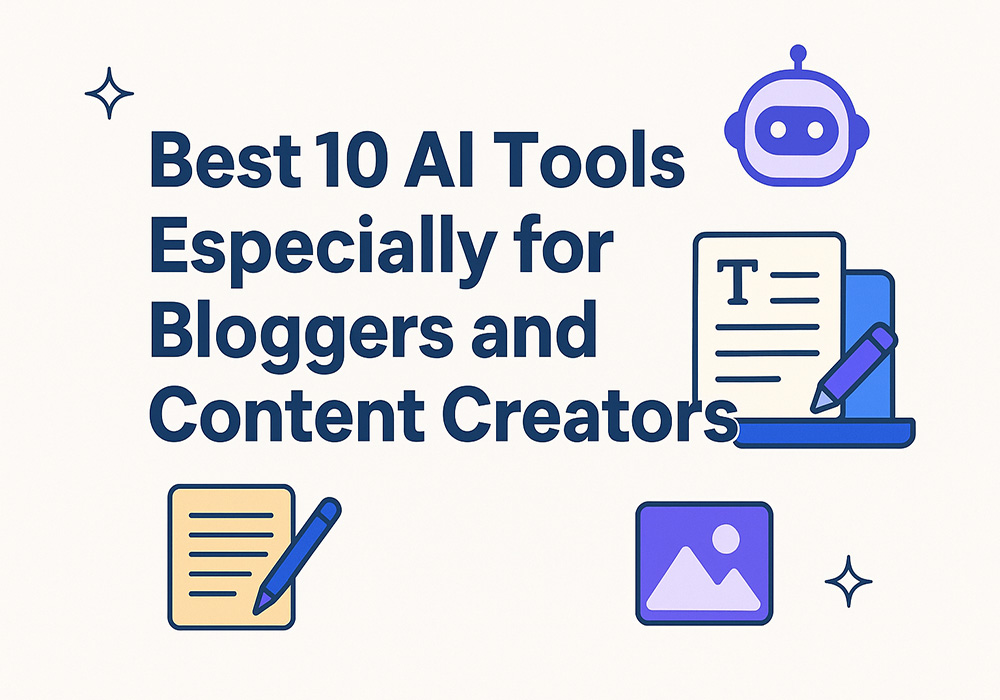
https://shorturl.fm/nk95D
https://shorturl.fm/zQz2N
https://shorturl.fm/Q32IK
https://shorturl.fm/E82ZF
https://shorturl.fm/rVckU
https://shorturl.fm/Yltqd
https://shorturl.fm/RLDKT
https://shorturl.fm/Vm34N
https://shorturl.fm/VlIHg
https://shorturl.fm/p72aJ
https://shorturl.fm/dZKvT
sn14vp
https://shorturl.fm/34sGX
https://shorturl.fm/mzhZs
uax9aj
0ird4x
l6o855
nxcy16
2v81b4
https://shorturl.fm/nytzn
izhrzd
https://shorturl.fm/Oierc
c8gcdy
https://shorturl.fm/2eeKv
https://shorturl.fm/O3XLX
h39j5m
https://shorturl.fm/N3LYR
https://shorturl.fm/ofIoO
https://shorturl.fm/IRzEz
https://shorturl.fm/tg6kW
https://shorturl.fm/VyGUD
https://shorturl.fm/vO0iI
zs7q22
https://shorturl.fm/29N2z
https://shorturl.fm/xnqHR
p1h517
https://shorturl.fm/cm0wK
ona2gg
https://shorturl.fm/J491T
https://t.me/official_1win_aviator/298
https://t.me/official_1win_aviator/69
https://shorturl.fm/RT7jC
https://shorturl.fm/4zIoD
https://t.me/s/ef_beef
I don’t think the title of your article matches the content lol. Just kidding, mainly because I had some doubts after reading the article.
https://shorturl.fm/8Lijf
I don’t think the title of your article matches the content lol. Just kidding, mainly because I had some doubts after reading the article. https://accounts.binance.com/sv/register-person?ref=GQ1JXNRE